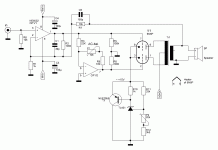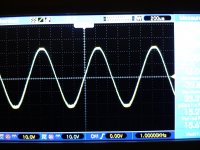Not at all. Just use Zeners in cathodes, or some kind of adjustable shunt regulators.
For example:
http://www.diyaudio.com/forums/power-supplies/166404-shunt-regulator-using-lm317-lm337.html
the zeners will arrive tomorrow, but i 'm not sure what to do here:
place them across the 470ohm cathode resistor (+ bypass cap)?
put it between cathode and ground without the rsistor?
in both cases, how do i know it won't let too much current through the tube?
the grid resistors are 10k, screen resistors 1k
place them across the 470ohm cathode resistor (+ bypass cap)?
put it between cathode and ground without the rsistor?
in both cases, how do i know it won't let too much current through the tube?

the grid resistors are 10k, screen resistors 1k
I think you mean grid stoppers are 10k.
The zener goes in place of the cathode resistor. However, if you are worried that you might have too low a zener voltage and so too high current for the valve you can always put some resistance in series with the zener for initial testing. This will also provide some protection from getting the zener back to front!
A 470R will give about 32V bias, so you need a minimum of 33V zener. I would try with a 33V zener and maybe 200 ohms in series. If that seems fine - low anode current - then remove the resistor.
The zener goes in place of the cathode resistor. However, if you are worried that you might have too low a zener voltage and so too high current for the valve you can always put some resistance in series with the zener for initial testing. This will also provide some protection from getting the zener back to front!
A 470R will give about 32V bias, so you need a minimum of 33V zener. I would try with a 33V zener and maybe 200 ohms in series. If that seems fine - low anode current - then remove the resistor.
thank you!
I think you mean grid stoppers are 10kyes, grid stoppers. it should be fine?
One way to have an adjustable fixed bias at the cathode, is to use TL431 voltage reference boosted with a PNP power transistor as in attached schematic.
I once tried this 6N6P PP amplifier at AB2 class with fixed bias by zeners at the cathode, but soon I noticed that zeners are even too "fixed" and the adjustable is practically "must".
I once tried this 6N6P PP amplifier at AB2 class with fixed bias by zeners at the cathode, but soon I noticed that zeners are even too "fixed" and the adjustable is practically "must".
Attachments
One way to have an adjustable fied bias...
that looks very elegant, but i wouldn't know how to calculate the correct values for my case
Cathode bias is fine for simpler, lower power amps, it´s very popular there.
But a couple EL34 at 440V +V is a serious beast , in fact you want such a thing, since you are worried about "low power".
The poorly named "crossover distortion " is just an extra annoyance
I suggest you go fixed bias and copy circuits and settings from any British Marshall amplifier, who have been doing things right with EL34 for over 50 years now.
Don´t reinvent the wheel.
But a couple EL34 at 440V +V is a serious beast , in fact you want such a thing, since you are worried about "low power".
The poorly named "crossover distortion " is just an extra annoyance
I suggest you go fixed bias and copy circuits and settings from any British Marshall amplifier, who have been doing things right with EL34 for over 50 years now.
Don´t reinvent the wheel.
Don´t reinvent the wheel.
you are right, of course. I just want to understand how things work, as much as possible, as i don't have any formal education in electronics.
This project came out of the blue for me, i had never seriously thought about building a tube amp, and i' having way too much fun
simply copying a circuit without having any idea of what's happening is not very appealing.
that's why i find you guys knowledge invaluable (and this forum in general)
that looks very elegant, but i wouldn't know how to calculate the correct values for my case
2.5v across the "sense" lead of the 431
http://www.ti.com/lit/ds/symlink/atl431.pdf
As you may calculate, up to 25V as drawn on Artosalo's schematic.
Last edited:
ok guys, just tried 33 and 36v zeners, it starts to clip at ~30 watts at 8ohm load (see attachement)
thanx again, i have a lot of homework to do
2.5v across the "sense" lead of the 431
http://www.ti.com/lit/ds/symlink/atl431.pdf
As you may calculate, up to 25V as drawn on Artosalo's schematic.
thanx again, i have a lot of homework to do
Attachments
i won't ask how it got that name
Solo guitarists who tried Hi-Fi amps on overdrive invented the name.
ok guys, just tried 33 and 36v zeners, it starts to clip at ~30 watts at 8ohm load (see attachement)
thanx again, i have a lot of homework to do
Just use like 68k resistor instead of 33k, to get up to ~50V bias.
Better sell it and buy some my amps.
now why would i do that?
evidently i'm a fantastic DIYer
now why would i do that?
evidently i'm a fantastic DIYer
Because I don't drink alcohol. Well, I can have some on a party, but don't enjoy it.
- Status
- This old topic is closed. If you want to reopen this topic, contact a moderator using the "Report Post" button.
- Home
- Amplifiers
- Tubes / Valves
- crossover distortion and other questions (first timer)



